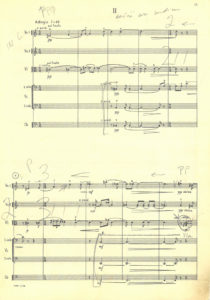Seventeen years after writing Concerto for String Orchestra Grażyna Bacewicz added to her oeuvre another piece for the same instrumental line-up. Its composition was prompted by a commission from Karol Teutsch – a violinist and conductor of the Chamber Ensemble of the Warsaw Philharmonic. When she received the commission, the composer was at a different stage of her creative journey than when she was when working on the Concerto. She was looking for new means of expression in the sonoristic technique, without giving up a logical, clearly planned form.
Her three-part Divertimento draws, as its title suggests, on eighteenth-century forms serving entertainment purposes. Thus it is lighter than the composer’s other pieces written in the same year, 1965. The development of the first movement (Allegro) is based on a sound complex comprising three “leaping” tritones of the first violins, set after their sound has died out on a five-bar sound band made up of the first and second violins on C4, viola tremolo on F4 sharp, cello tremolando on notes B–D and finally a sustained F in the double bass. If we add to this the fact that the opening tritone – D5 sharp diminished fifth and flageolet A5 – is reached by means of a glissando, while the remaining two: G5 sharp–flageolet D5 and C4 sharp–G4, are played staccato with an appropriate bowing – we get the full picture of intended “skittishness” of this Allegro. The energy of the first complex – “roguish” tritones with different rhythms and “rest” on a long sound – is a characteristic motif of the movement, presented in various configurations. But this is not the whole content. Worthy of note are dreamlike, high flageolet strands of the divided first violin and viola, supported by an arhythmic ostinato of the second violin as well as a drone of the cellos and double basses in the middle fragment, immediately followed by ostinato figures in all instruments, with a constant exchange of components, sounding almost like a self-quotation from earlier pieces.
The unaffected, cheerful mood of the Allegro gives way in the Adagio to nostalgia and reflection in contrapuntal tangles of instruments sometimes treated as solo instruments. The main motif is a figure built of a gently ascending and descending tritone (with the exception of a pure fifth in the second violin in the eight bar). The initially quiet mood reaches a climax in an expressive tutti, only to become immersed again in a perdendosi, indicated several times.
The final Giocoso is a display of textural and articulation ideas – from the initial saltando of the viola, pizzicato of the second violin to saltando glissando of the first violin, with everything being focused in the anacrusis and first bar. It seems that the composer wanted to accumulate within a short section all ideas concerning texture and articulation in the strings, and it has to be said that it is not just a catalogue of various string tricks, but a real, lively kaleidoscope of changing sound situations – from the polyphony of sound bands, that is parallel ostinato of diverse figures in the various voices, to situations marked by genuine wit, like, for example, the “swaying” glissando running from F6 to B5 and back in the first violins, performed by the second violins an octave lower (number 3). In addition to various ostinatos, tremolos and tremolandos, there is also a short episode featuring fingering passages characteristic of the composer bowing technique. This term is used by Maryla Renat (“Wybrane zagadnienia idiomu kompozytorskiego Grażyny Bacewicz”, Częstochowa 2005) to describe structures based on a small sound cell transposed in a similar arrangement a fifth up or down.
Technically, this means that the entire passage is to be performed in the same position, but with a change of strings.
Interval scales typical of Bacewicz’s compositional technique, built of chromatically shifting small cells, take control of number 8 – they are played ordinario and then sul ponticello, which obviously creates a comic effect. Above all, however, some of these effects as well as delicate flageolet ostinatos in number 7 create a colourful picture testifying to the composer’s extraordinary colour imagination.
- Divertimento for String Orchestra, PWM, mov. 1
- Divertimento for String Orchestra, PWM, mov. 2
- Divertimento for String Orchestra, PWM, mov. 3


